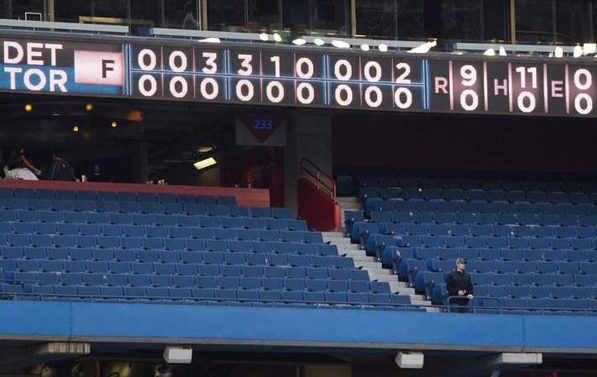

Each team in Major League Baseball desires to have at least one, true staff anchor; a pitcher who you know you can rely on for above-average starts night in and night out, and who also has the natural ability to toss up a pure gem from time to time. Being a staff “ace” and staff “anchor” can mean the same thing depending on who you talk to, or they can differ slightly.
An “ace” usually signifies the most talented in terms of raw talent and ability; the guy with the highest K/9, largest arsenal of pitches, three digits on the gun, etc. “Ace” is to flashy brilliance as “anchor” is to consistent greatness, at least for this exercise.
My argument is that the same metrics used for scouting and projecting a pitcher’s future performance at the major-league level don’t tell the full story of a pitcher once he’s established himself in the game. Looking at rate stats can show you the potential a pitcher’s stuff has, or how likely he is to demonstrate control through a full game, or even if his arsenal is more susceptible to being launched out of the park on a regular basis.
Once a pitcher has demonstrated that he belongs at the major-league level, we need a different measure to calculate his consistency. Showing that you can be great on back-to-back-to-back starts not only proves you have stuff, but also the mental toughness, focus and durability that fully encompasses what a great pitcher is. It’s hard to measure the psychological part of the game, but a player who demonstrates a consistency of above-average results is said to have greater composure and is less likely to ever have an on-field, career-threatening meltdown a la Chuck Knoblauch, Dontrelle Willis or Slick Rick Ankiel.
How will we measure consistency? Bill James introduced the “game score” statistic years back to quantify how dominant a pitcher was on a game-by-game basis.
To determine a starting pitcher’s game score: (1) Start with 50 points. (2) Add one point for each out recorded, so three points for every complete inning pitched. (3) Add two points for each inning completed after the fourth. (4) Add one point for each strikeout. (5) Subtract two points for each hit allowed. (6) Subtract four points for each earned run allowed. (7) Subtract two points for each unearned run allowed. (8) Subtract one point for each walk.
For determining who holds the title of “truest staff anchor” heading into 2012, we will do some analysis on pitcher’s game scores from the 2011 season. I chose to nitpick the top four starting pitchers in 2011 Cy Young voting from each league, and then two other arbitrary selections.
Key:
Gsc Range: The lowest-highest rated games a pitcher pitched.
90+: The number of supremely dominant games a pitcher pitched. Example: Verlander’s “94” was a nine inning, two hit shutout with 12 strikeouts.
Avg Gsc: Add up all 2011 game scores and divide by the number of starts made … pretty simple.
SD: Standard deviation of 2011 game scores.
Outliers: Game scores that fell more than two standard deviations away from the mean … these game scores will still be included in the mean and standard deviation calculations.
| Name | Gsc Range | 90+ | Avg Gsc | SD | Outliers |
| Justin Verlander | 32-94 | 2 | 65.61 | 14.42 | 32 |
| Jered Weaver | 17-88 | 0 | 62.94 | 16.68 | 26,17 |
| James Shields | -2-93 | 1 | 62.85 | 20.82 | 19, -2 |
| CC Sabathia | 31-87 | 0 | 58.76 | 14.67 | n/a |
| Clayton Kershaw | 32-93 | 2 | 64.79 | 15.79 | 32 |
| Roy Halladay | 31-83 | 0 | 63.31 | 13.12 | 36,31 |
| Ian Kennedy | 8-91 | 2 | 59.91 | 16.72 | 25,8 |
| Cliff Lee | 18-92 | 1 | 64.06 | 18.60 | 26,18 |
| Tim Lincecum | 17-87 | 0 | 59.61 | 17.60 | 17 |
| C.J. Wilson | 22-83 | 0 | 57.76 | 15.58 | 25,24,22 |
(thanks to www.baseballreference.com for the game score numbers)
What do we have here?
Stated previously, we are looking for pitchers who are good, all the time. The more a pitcher can dominate games, and the less he bombs starts, the better chance his team has of winning games. Winning games is what it’s all about.
To start, the most consistent 2011 pitcher on this list is Halladay with a standard deviation of game scores at 13.12. The lower the standard deviation, the lower the variability of his starts. On average, he tosses up a 63.31 game score, which is similar to this stat line:
8 IP, 8 H, 2 ER, 1 BB, 8 K
That’s going to win, or at least keep your team in, a ton of ball games. Does this alone make Halladay the truest staff anchor? His chart data has a few detractors. First, his ceiling was a little low, in that he didn’t have any supremely dominant games with over a 90+ game score, as he topped out at 83. Also, he had two starts that were so bad that they were considered outliers compared to the rest of his data set.
Sabathia is the next interesting case. He was extremely consistent, registering the third lowest standard deviation. In context to his data set, he didn’t have any starts that were so bad that they could be considered outliers. Examined further, you can see that Sabathia’s mean game score was the second lowest in the group (lower than Kennedy and Lincecum), so while he didn’t have any “outlier” bad starts, his worst start would have been considered an outlier if it was in Halladay’s data set. Generally, Sabathia didn’t pitch as well over the course of the year as Halladay, so Sabathia’s bad start didn’t look as weird as it would have if Halladay had pitched it.
That leaves Verlander, and he is without a doubt, the truest staff anchor heading into the 2012 season. He dominates the chart, amassing the highest mean game score while having the second best consistency. He threw two supremely great starts, and only had one truly horrible start. He displays the mental toughness and durability that when coupled with natural ability, makes a starting pitcher truly great.





